The 5th Century BCE Greek poet Pindar wrote of a mythical place called Hyperborea – a place “that lay behind cold Boreas of bleak and frozen breath.” – a place that was unreachable:
“Of the fairest glories that mortals may attain, to him is given to sail to the furthest bound. Yet neither ship nor marching feet may find the wondrous way to the gatherings of the Hyperborean people.”
According to the 2nd Century CE Greek poet Aelian the Hyperboreans were giants in stature:
“The race of the Hyperboreans and the honors there paid to Apollo are sung of by poets and are celebrated by historians…This god [Apollo] has as priests the sons of Boreas (the North Wind) and Khione (snow), three in number, brothers by birth, and six cubits [9 feet] in height.”
The 1st Century CE Roman scholar Pliny the Elder believed that Hyperborea was a real place north of the Ripaean Mountains, known today at the Carpathians, which extend across Central Europe.

Greek Temples
Two sites in Greece may provide clues as to the location of Hyperborea. Jean Richer (2007) argued that the Temple of Apollo at Delphi, which is oriented in a northwest direction, references two important directions – one southeast toward the island of Crete, which is the birthplace of Zeus and the origin of all of the Greek gods, and the other northwest in the direction of Hyperborea. The Temple of Hera at Samothrace is similarly aligned in a northwest direction with “symbolic north” directed toward Mt.Haemus (Balkan Mountains), beyond which the Greeks believed was the realm of Hyperborea.
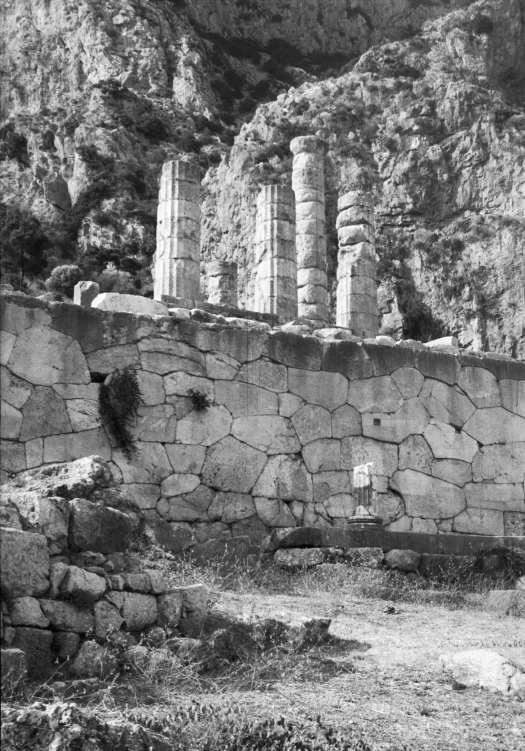
The original temple dedicated to Apollo at Delphi is thought to have been built in the 7th century BCE. Today’s temple is roughly in alignment with the summer solstice sunrise. A careful examination of the site reveals other geometrical alignments. The polygonal wall below the temple and behind the Stoa (Portico) of the Athenians, which is made of polygonal stones similar to “cyclopean” walls found both in Europe and other parts of the world, is at a right angle to the direction of the Hudson Bay pole. So too is the orientation of the amphitheater. The opposing direction points directly toward the Cave of Zeus on Crete.
Geometry of the Hudson Bay Pole Shift
If references to Hyperborea are in the direction of the former North Pole in Hudson Bay, then from the point of view of the Greeks, when the pole shifted from Hudson Bay to its current location, certain parts of Europe, most notably those in northeast Europe which were at a lower latitude and more temperate in climate would have been shifted northward into the Arctic Circle. These places could thus be interpreted as now being “beyond north” and unreachable in the sense that they had existed at a different time in a previous age but are now gone as a result of the resulting cataclysm.
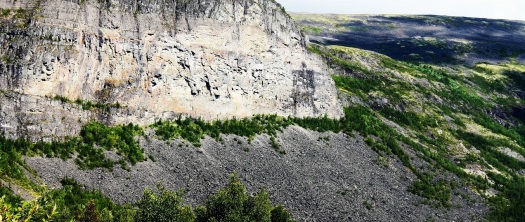
An Anomaly in Northern France
Could the last pole shift have destroyed a civilization that had existed northward from the Carpathian Mountains to Scandinavia and west to the British Isles and east to Siberia, and if so is there any evidence of its existence? A search for archaeological ruins in this area aligned to the former pole revealed little evidence other than a few curious features on the Solovetsky Islands in the White Sea, and a geoglyph facing north-northwest on the side of a mountain in the middle of the Kola Peninsula.
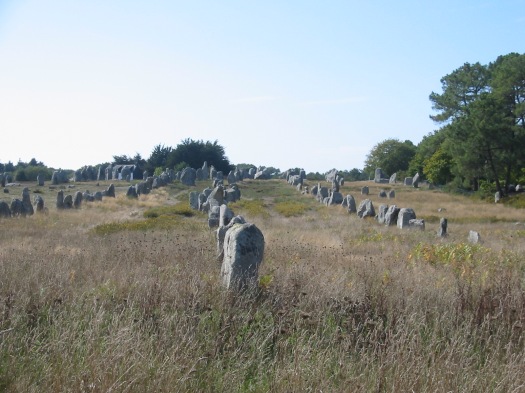
Moving on to megalithic sites in Scandinavia and continuing west to the British Isles, and then south to mainland Europe more than a dozen sites were found that appeared to be aligned to a geo-location in or near modern-day Paris. The oldest sites (late Neolithic) were not oriented in directions that coincide with celestial directions such as solstice sunrise/sunset and lunar standstill moonrise/moonset. However, later sites (Bronze Age onward) were oriented both in celestial directions and toward Paris. (Click here to read the paper.)
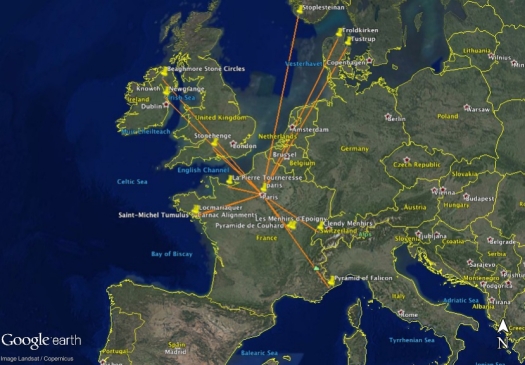
Before the advent of radiocarbon dating, archaeologists believed that the megalithic tradition in Europe had spread westward from the Near East. Based on a statistical analysis of thousands of radiocarbon-dated samples from megalithic sites across Europe Schulz Paulsson (2019) concluded that the megalithic phenomenon in Europe originated independently in northwest France during the fifth millennium BCE.
The concept of the “omphalos” or center is referenced by ancient civilizations and religious/spiritual traditions in the context of sacred stones that are kept in places of importance. Examples include the Omphalos of Delphi, the Black Stone in the Kaaba at Mecca, and others. Richer (2007) believed that Greek oracles including the Temple of Apollo at Delphi were aligned to specific locations, one being Mt. Ida on the island of Crete, which was thought to have been the birthplace of Zeus. The city of Cuzco, which translates as “navel” in Quechua, is the point of origin of radial lines called “ceques” that emanate from the city in all directions (Farrington 2018).
That sites up to 1000 km distant point toward a location in a region that was also an independent place of origin of the megalithic tradition in Europe is an interesting coincidence.
From Myth to Prehistory
Certain passages in Plato’s two dialogs that discuss Atlantis are often overlooked because they discuss Athens in the context of its war with Atlantis. What is significant in these passages is that that they refer to the existence of an earlier civilization, perhaps referencing the “Heroic Age” of Greece. From Timeus:
“…you do not know that there formerly dwelt in your land the fairest and noblest race of men which ever lived, and that you and your whole city are descended from a small seed or remnant of them which survived. And this was unknown to you, because, for many generations, the survivors of that destruction died, leaving no written word. For there was a time, Solon, before the great deluge of all, when the city which now is Athens was first in war and in every way the best governed of all cities, is said to have performed the noblest deeds and to have had the fairest constitution of any of which tradition tells, under the face of heaven.”
We learn a little more from Critias
“For when there were any survivors, as I have already said, they were men who dwelt in the mountains; and they were ignorant of the art of writing, and had heard only the names of the chiefs of the land, but very little about their actions.”
Although there do not appear to be any archaeological ruins (i.e., megalithic sites) in northern Europe that are in alignment with the Hudson Bay pole it is possible that what had existed in this part of the world was destroyed by the ensuing cataclysm. A plausible explanation for the emergence of the megalithic phenomena is northern Europe and the alignment of ancient sites to a place that is now Paris is that the memory of a previous (prehistoric) civilization persisted for some time after its destruction. It is hypothesized that this civilization could have been the Hyperboreans of Greek myth and the ancient Athenians mentioned in Plato’s two dialogs.
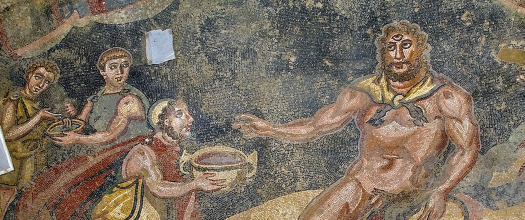
These myths may provide a prehistoric context not only for Hyperboreans but for other mythical creatures such as the Cyclops. Richard Cassaro suggests that the Cyclops, who are were also thought to have been giants, might have been the builders of numerous megalithic structures in Europe whose origins are unknown or uncertain.
References
Farrington, Ian (2018). The Oxford Handbook of the Incas, (Sonia Alconini and R. Alan Covey, eds.) Oxford University Press.
Richer, Jean (1994) Sacred Geography of the Ancient Greeks, State University of New York Press, Albany.
Schulz Paulsson, B. (2019) “Radiocarbon dates and Bayesian modeling support maritime diffusion model for megaliths in Europe,” Proceedings National Academy of Sciences, Vol. 116, No. 9. (http:// www.pnas.org/cgi/doi/10.1073/pnas.1813268116).


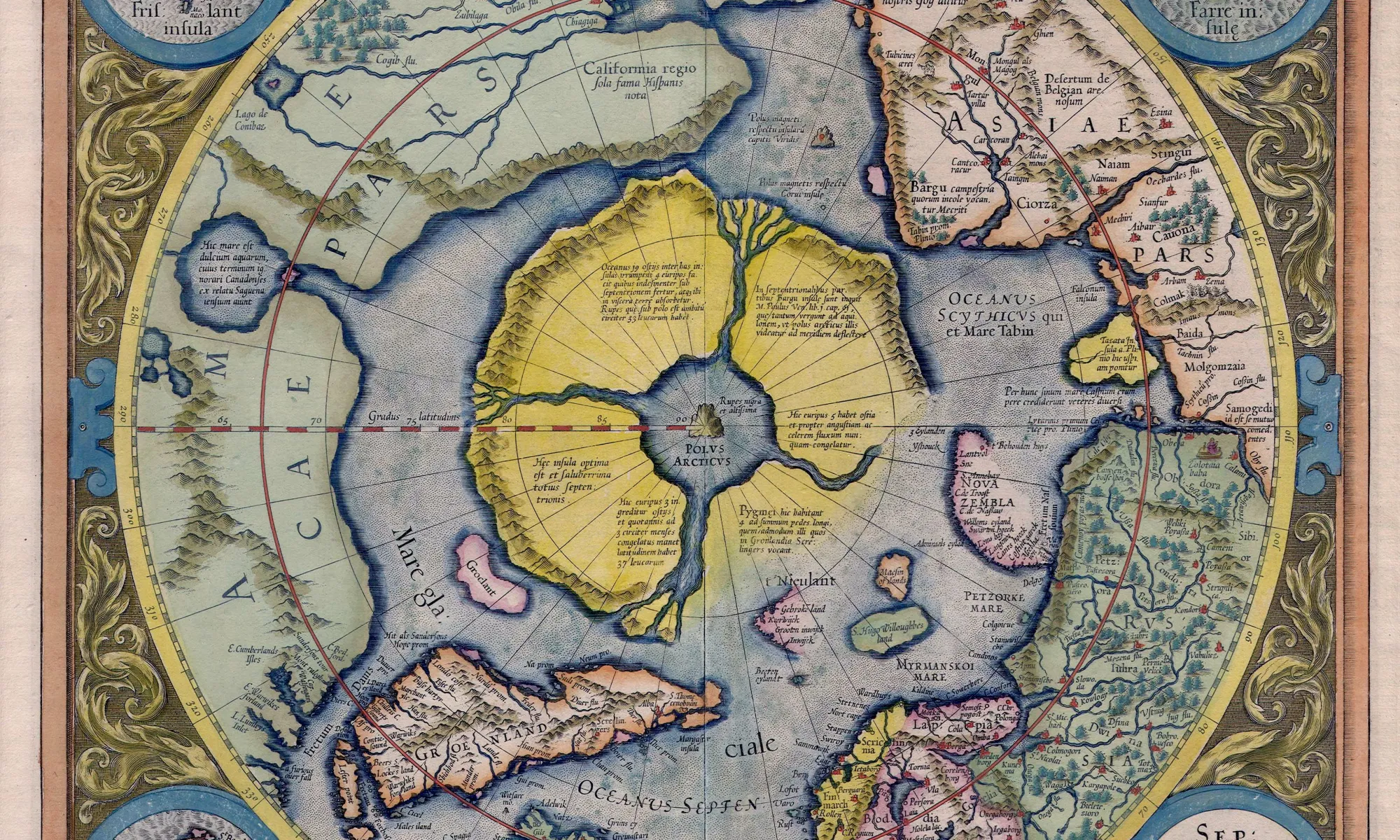
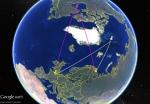

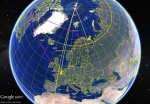

LikeLiked by 1 person
Sorry, for the late reply but I just noticed your post from more than 2 years ago. Very interesting correlations! Thank you for pointing them out.
LikeLike
Muchas gracias. ?Como puedo iniciar sesion?
LikeLike
Muchas gracias. ?Como puedo iniciar sesion?
LikeLike
Muchas gracias. ?Como puedo iniciar sesion?
LikeLike